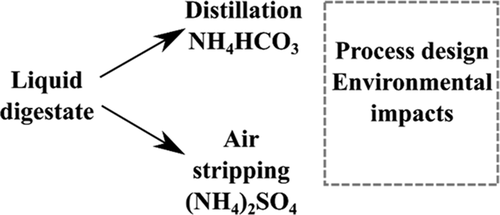当前位置:
X-MOL 学术
›
ACS Sustain. Chem. Eng.
›
论文详情
Our official English website, www.x-mol.net, welcomes your
feedback! (Note: you will need to create a separate account there.)
Transformation of Liquid Digestate from the Solid-Separated Biogas Digestion Reactor Effluent into a Solid NH4HCO3 Fertilizer: Sustainable Process Engineering and Life Cycle Assessment
ACS Sustainable Chemistry & Engineering ( IF 7.1 ) Pub Date : 2020-12-24 , DOI: 10.1021/acssuschemeng.0c08374 Donata Drapanauskaite 1, 2 , Robert M. Handler 3 , Nicholas Fox 1 , Jonas Baltrusaitis 1
ACS Sustainable Chemistry & Engineering ( IF 7.1 ) Pub Date : 2020-12-24 , DOI: 10.1021/acssuschemeng.0c08374 Donata Drapanauskaite 1, 2 , Robert M. Handler 3 , Nicholas Fox 1 , Jonas Baltrusaitis 1
Affiliation

|
The growing interest in biogas production to obtain renewable electricity has led to the increasing availability of liquid digestate byproducts containing major nutrients, such as nitrogen, and the need for sustainable engineering developments toward its utilization. Currently, digestate return to the fields has been most popular but suffers from many problems, such as potent greenhouse gas emissions, including N2O, during storage, transport, and application. This work describes a newly designed process for the production of solid nitrogen fertilizers from liquid biogas production waste that circumvents many of the problems associated with handling and applying liquid digestate. In particular, solid ammonium bicarbonate (NH4HCO3) is engineered using solid separated biogas digestion reactor effluent to yield sustainable nitrogenous fertilizers. NH4HCO3 is considered a marketable fertilizer with a N content of 18% that represents an added value to the biogas producing facilities. The process design was performed to obtain an optimized recovery with virtually no nitrogen losses. The process developed relies on digestate distillation at 3.3 bar with the condenser operating at 49 °C and using cooling water. Solid crystals are obtained in a crystallizer at 12 °C and recovered via drying. For comparison, an open-loop air stripping process was developed to obtain ammonium sulfate ((NH4)2SO4) solid fertilizer. The resulting economics of both processes show that the capital cost associated with the NH4HCO3 process is much lower together with the consumption of the utilities. A life cycle assessment approach was used to evaluate the environmental impacts of the new NH4HCO3 process using distillation and the (NH4)2SO4 process using air stripping technology, compared to the base case with liquid digestate applied directly onto the fields. The two primary impact categories of concern in this technical area are global warming potential (GWP) and eutrophication potential (EP). In particular, NH4HCO3 and (NH4)2SO4 processes have ∼25% lower GWP impact because of the reduced land application which is negated because of the utility use. EP was reduced by ∼50 and 20%. Notable was the negative and sizeable effect of both scenarios on ecotoxicity which stemmed from the need to use defoaming agents to address any potential transport problems across the vapor/liquid boundary.
中文翻译:

从固体分离的沼气消化反应器废液到有机NH 4 HCO 3固体肥料的液态消化转化:可持续过程工程和生命周期评估
人们对沼气生产以获取可再生电力的兴趣日益浓厚,导致含有主要营养素(例如氮)的液态消化副产物的供应量增加,并且需要对其进行可持续工程开发。目前,消化返回到田里一直最流行的,但患有许多问题,如强效的温室气体排放,包括N个2 O,在储存,运输,和应用程序。这项工作描述了一种新设计的方法,用于从液态沼气生产废料生产固态氮肥,该工艺规避了与处理和施用液态消化物有关的许多问题。尤其是固体碳酸氢铵(NH 4 HCO 3)是使用固体分离的沼气消化反应器废水进行工程设计的,以生产可持续的含氮肥料。NH 4 HCO 3被认为是一种可销售的肥料,其氮含量为18%,代表了沼气生产设备的附加值。进行工艺设计以获得几乎没有氮损失的优化回收率。开发的方法依赖于在3.3 bar下进行消化蒸馏,冷凝器在49°C下运行,并使用冷却水。在12℃的结晶器中获得固体晶体,并通过干燥回收。为了进行比较,开发了一种开环空气汽提工艺以获得硫酸铵((NH 4)2 SO 4)固体肥料。两种方法所产生的经济学结果表明,与NH 4 HCO 3方法相关的资本成本以及公用事业的消耗要低得多。与将液体消化液直接应用于田间的基本情况相比,使用生命周期评估方法来评估使用蒸馏的新NH 4 HCO 3工艺和使用空气汽提技术的(NH 4)2 SO 4工艺的环境影响。。该技术领域关注的两个主要影响类别是全球变暖潜力(GWP)和富营养化潜力(EP)。尤其是NH 4 HCO 3(NH 4)2 SO 4工艺的GWP影响降低约25%,这是因为减少了土地用途,而由于公用事业用途而被否定了。EP降低约50%和20%。值得注意的是,这两种情况对生态毒性的负面影响都很大,这是由于需要使用消泡剂解决跨汽/液边界的任何潜在运输问题。
更新日期:2021-01-11
中文翻译:

从固体分离的沼气消化反应器废液到有机NH 4 HCO 3固体肥料的液态消化转化:可持续过程工程和生命周期评估
人们对沼气生产以获取可再生电力的兴趣日益浓厚,导致含有主要营养素(例如氮)的液态消化副产物的供应量增加,并且需要对其进行可持续工程开发。目前,消化返回到田里一直最流行的,但患有许多问题,如强效的温室气体排放,包括N个2 O,在储存,运输,和应用程序。这项工作描述了一种新设计的方法,用于从液态沼气生产废料生产固态氮肥,该工艺规避了与处理和施用液态消化物有关的许多问题。尤其是固体碳酸氢铵(NH 4 HCO 3)是使用固体分离的沼气消化反应器废水进行工程设计的,以生产可持续的含氮肥料。NH 4 HCO 3被认为是一种可销售的肥料,其氮含量为18%,代表了沼气生产设备的附加值。进行工艺设计以获得几乎没有氮损失的优化回收率。开发的方法依赖于在3.3 bar下进行消化蒸馏,冷凝器在49°C下运行,并使用冷却水。在12℃的结晶器中获得固体晶体,并通过干燥回收。为了进行比较,开发了一种开环空气汽提工艺以获得硫酸铵((NH 4)2 SO 4)固体肥料。两种方法所产生的经济学结果表明,与NH 4 HCO 3方法相关的资本成本以及公用事业的消耗要低得多。与将液体消化液直接应用于田间的基本情况相比,使用生命周期评估方法来评估使用蒸馏的新NH 4 HCO 3工艺和使用空气汽提技术的(NH 4)2 SO 4工艺的环境影响。。该技术领域关注的两个主要影响类别是全球变暖潜力(GWP)和富营养化潜力(EP)。尤其是NH 4 HCO 3(NH 4)2 SO 4工艺的GWP影响降低约25%,这是因为减少了土地用途,而由于公用事业用途而被否定了。EP降低约50%和20%。值得注意的是,这两种情况对生态毒性的负面影响都很大,这是由于需要使用消泡剂解决跨汽/液边界的任何潜在运输问题。


















































 京公网安备 11010802027423号
京公网安备 11010802027423号